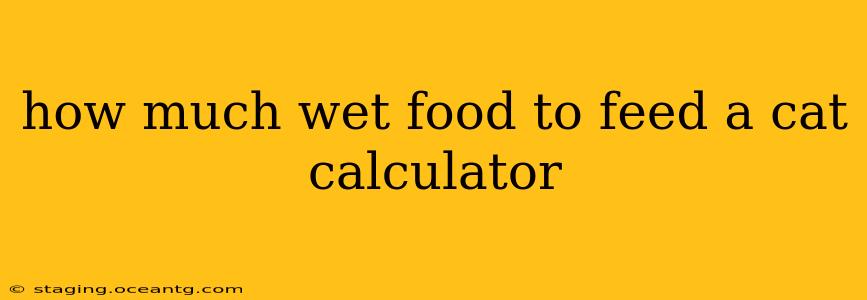Determining the perfect amount of wet food for your feline companion can feel like navigating a maze. Too little, and they might be hungry and undernourished. Too much, and you risk contributing to weight gain and related health problems. This comprehensive guide will help you understand the factors influencing your cat's dietary needs and provide you with practical tools to calculate the right amount of wet food. We'll even address common questions cat owners have about feeding their furry friends.
Understanding Your Cat's Unique Needs
Before we dive into the calculations, it's crucial to understand that there's no one-size-fits-all answer. Your cat's daily wet food intake depends on several key factors:
- Age: Kittens require more calories than adult cats due to their rapid growth. Senior cats, on the other hand, often need fewer calories due to a slower metabolism.
- Weight: A heavier cat will naturally require more food than a smaller cat. A healthy weight is crucial for your cat's overall wellbeing.
- Activity Level: A highly active cat will burn more calories than a less active indoor cat.
- Breed: Certain breeds have different metabolic rates and energy requirements.
- Health Conditions: Underlying health issues, such as hyperthyroidism or diabetes, can significantly impact your cat's caloric needs. Always consult your veterinarian for guidance if your cat has any health concerns.
- Type of Wet Food: The calorie density varies significantly between different brands and types of wet food. Always check the nutritional information on the can or pouch.
How to Use a Wet Food Feeding Calculator (General Guidelines)
While a precise calculator requires individual cat information and a veterinary consultation for optimal accuracy, general guidelines exist. Most wet food manufacturers provide feeding guidelines on their packaging based on weight. These guidelines are usually a starting point and often need adjustment based on the factors mentioned above.
General Rule of Thumb (Use with Caution): A good starting point is to feed approximately 1.5-2% of your cat's ideal body weight in wet food per day. This translates to:
- A 10lb cat: 15-20 grams (0.5 - 0.7 oz) of wet food per day, roughly half to three-quarters of a 3 oz can.
- A 15lb cat: 22.5-30 grams (0.8 - 1 oz) of wet food per day, roughly one to one and a quarter of a 3 oz can.
Important Note: These are just rough estimates. Observe your cat's body condition and adjust the amount accordingly. A healthy cat will have a visible waistline and ribs that are easily felt but not prominent.
Common Questions about Feeding Your Cat Wet Food
Here are some frequently asked questions about feeding wet food to cats, often found in the "People Also Ask" section of search engines:
How much wet food should I feed my kitten?
Kittens have higher caloric needs than adult cats. Their food intake should be adjusted based on their rapid growth. Consult your veterinarian for specific recommendations tailored to your kitten's age, breed, and activity level. They'll likely recommend feeding smaller, more frequent meals throughout the day.
Can I mix wet and dry food?
Yes, many cat owners successfully mix wet and dry food. This can be a good way to provide variety and ensure your cat gets a balanced diet. However, be sure to adjust the total daily food intake to avoid overfeeding. Remember to factor in the calories from both the wet and dry food.
My cat is overweight, how much wet food should I give it?
If your cat is overweight, consult your veterinarian. They can help you create a weight-loss plan that includes adjusting your cat's food intake and incorporating more exercise. Gradually reduce the amount of wet food while monitoring your cat's weight and energy levels.
What are the benefits of feeding my cat wet food?
Wet food typically has a higher moisture content than dry food, which can be beneficial for cats prone to urinary tract issues. Many cats also find wet food more palatable and enjoyable to eat.
How do I know if my cat is getting enough food?
Monitor your cat's body condition. A healthy cat will have a visible waistline and easily palpable ribs, but they shouldn't be prominent. Observe their energy levels and activity. If your cat seems lethargic or excessively hungry, consult your veterinarian.
Conclusion
Finding the right amount of wet food for your cat is an iterative process. Using the general guidelines as a starting point and consistently monitoring your cat’s weight, body condition, and activity level will help you find the ideal amount to keep your furry friend happy and healthy. Remember, consulting your veterinarian for personalized advice is always the best course of action. They can help you create a feeding plan specifically tailored to your cat's individual needs.
